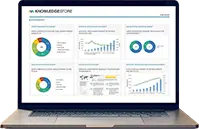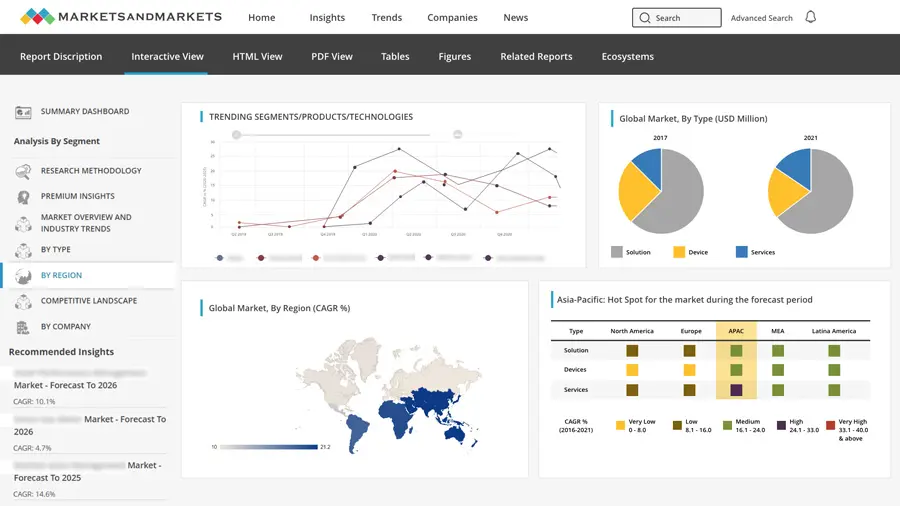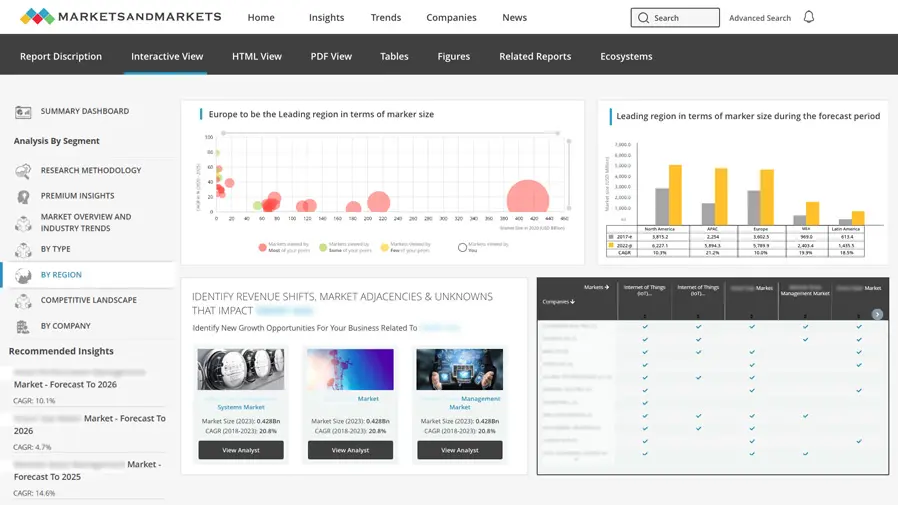TABLE OF CONTENTS
1 Introduction
1.1. Study Objectives
1.2. Market Definition and Scope
1.2.1. Inclusions and Exclusions
1.3. Study Scope
1.3.1. Markets Covered
1.3.2. Geographic Segmentation
1.3.3. Years Considered for the study
1.4. Currency
1.5. Limitations
1.6. Stakeholders
2 Research Methodology
2.1. Research Data
2.1.1. Secondary Data
2.1.1.1. Major Secondary Sources
2.1.1.2. Key Data from Secondary Sources
2.1.2. Primary Data
2.1.2.1. Primary Interviews with Experts
2.1.2.2. Key Data from Primary Sources
2.1.2.3. Key Industry Insights
2.1.2.4. Breakdown of Primaries
2.2. Market Size Estimation
2.2.1. Bottom-Up Approach
2.2.1.1. Approach for Capturing Market Share by Bottom-Up Analysis (Demand Side)
2.2.2. Top-Down Approach
2.2.2.1. Approach for Capturing Market Share by Top-Down Analysis (Supply Side)
2.3. Market Breakdown and Data Triangulation
2.4. Research Assumptions
2.5. Risk Assessment
2.6. Limitations of Research
3 Executive Summary
4 Premium Insights
5 Market Overview
5.1. Introduction
5.2. Market Dynamics
5.3. Trends/Disruptions Impacting Customer’s Business
5.4. Pricing Analysis
5.4.1. Indicative Pricing Analysis, For Key Players, By Technology
5.4.2. Indicative Pricing Analysis, By Region
5.5. Value Chain Analysis
5.6. Ecosystem Analysis
5.7. Technology Analysis
5.7.1. Key Technologies
5.7.2. Complementary Technologies
5.7.3. Adjacent Technologies
5.8. Patent Analysis
5.9. Trade Analysis
5.9.1. Import Scenario
5.9.2. Export Scenario
5.10. Key Conferences and Events (2025-2026)
5.11. Case Study Analysis
5.12. Investment and Funding Scenario
5.13. Regulatory Landscape
5.13.1. Regulatory Bodies, Government Agencies, and Other Organizations
5.13.2. Key Regulations
5.14. Porters Five Force Analysis
5.14.1. Threat from New Entrants
5.14.2. Threat of Substitutes
5.14.3. Bargaining Power of Suppliers
5.14.4. Bargaining Power of Buyers
5.14.5. Intensity of Competitive Rivalry
5.15. Key Stakeholders and Buying Criteria
5.15.1. Key Stakeholders in Buying Process
5.15.2. Buying Criteria
5.16. Impact of AI on Storage Class Memory Market
6 Storage Class Memory (SCM) Market, By Type
6.1. Introduction
6.2. Persistent Memory
6.3. Caching Memory
6.4. In-memory Computing
6.5. Others
7 Storage Class Memory (SCM) Market, By Technology
7.1. Introduction
7.2. Phase Change Memory (PCM)
7.3. Resistive Random-access Memory (RRAM)
7.4. STT-RAM (Spin-Transfer Torque RAM)
7.5. Flash-based SCM
7.6. Others
8 Storage Class Memory (SCM) Market, By Deployment Model
8.1. Introduction
8.2. Public Cloud
8.3. Private Cloud
8.4. Hybrid Cloud
9 Storage Class Memory (SCM) Market, By Application
9.1. Introduction
9.2. Generative AI
9.2.1. Rule-based Models
9.2.2. Statistical Models
9.2.3. Deep Learning
9.2.4. Generative Adversarial Networks (GANs)
9.2.5. Autoencoders
9.2.6. Convolutional Neural Networks (CNNs)
9.2.7. Transformer Models
9.3. Machine Learning
9.4. Natural Language Processing
9.5. Computer Vision
10 Storage Class Memory (SCM) Market, By End User
10.1. Introduction
10.2. IT & Telecommunications
10.3. Healthcare & Life Sciences
10.4. Financial Services
10.5. Automotive & Transportation
10.6. Manufacturing
10.7. Retail & E-commerce
10.8. Government & Public Sector
10.9. Others
11 Storage Class Memory (SCM) Market, By Region
11.1. Introduction
11.2. North America
11.2.1. Macro-Economic Outlook
11.2.2. US
11.2.3. Canada
11.2.4. Mexico
11.3. Europe
11.3.1. Macro-Economic Outlook
11.3.2. Germany
11.3.3. UK
11.3.4. France
11.3.5. Spain
11.3.6. Italy
11.3.7. Poland
11.3.8. Nordics
11.3.9. Rest of Europe
11.4. Asia Pacific
11.4.1. Macro-Economic Outlook
11.4.2. China
11.4.3. Japan
11.4.4. South Korea
11.4.5. India
11.4.6. Australia
11.4.7. Indonesia
11.4.8. Malaysia
11.4.9. Thailand
11.4.10. Vietnam
11.4.11. Rest of Asia Pacific
11.5. RoW
11.5.1. Macro-Economic Outlook
11.5.2. Middle East
11.5.2.1. Bahrain
11.5.2.2. Kuwait
11.5.2.3. Oman
11.5.2.4. Qatar
11.5.2.5. Saudi Arabia
11.5.2.6. United Arab Emirates (UAE)
11.5.2.7. Rest of Middle East
11.5.3. Africa
11.5.3.1. South Africa
11.5.3.2. Other African Countries
11.5.4. South America
12 Storage Class Memory (SCM) Market, Competitive Landscape
12.1. Introduction
12.2. Key player strategies/right to win
12.3. Revenue Analysis
12.4. Market Share Analysis
12.5. Company Valuation and Financial Metrics
12.6. Brand/Product Comparison
12.7. Company Evaluation Matrix: Key Players, 2024
12.7.1. Stars
12.7.2. Emerging Leaders
12.7.3. Pervasive Players
12.7.4. Participants
12.7.5. Company Footprint: Key Players, 2024
12.7.5.1. Company Footprint
12.7.5.2. Region Footprint
12.7.5.3. End User Footprint
12.7.5.4. Technology Footprint
12.7.5.5. Deployment Model Footprint
12.8. Company Evaluation Matrix: Startups/SMEs, 2024
12.8.1. Progressive Companies
12.8.2. Responsive Companies
12.8.3. Dynamic Companies
12.8.4. Starting Blocks
12.8.5. Competitive Benchmarking: Startups/SMEs, 2024
12.8.5.1. Detailed List of Key Startups/SMEs
12.8.5.2. Competitive Benchmarking of Key Startups/SMEs
12.9. Competitive Situation and Trends
12.9.1. Product Launches
12.9.2. Acquisitions
12.9.3. Partnerships, Collaborations, Alliances, and Joint Ventures
13 Storage Class Memory (SCM) Market, Company Profiles
13.1. Key Players
13.1.1. SAMSUNG
13.1.2. Western Digital Corporation
13.1.3. Everspin Technologies Inc.
13.1.4. Avalanche Technology
13.1.5. KIOXIA Singapore Pte. Ltd.
13.1.6. NVE Corporation
13.1.7. Renesas Electronics Corporation.
13.1.8. Infineon Technologies AG
13.1.9. Honeywell International Inc.
13.1.10. Numem Inc.
13.2. Other Players
14 Appendix
14.1. Discussion Guide
14.2. Knowledge Store: MarketsandMarkets’ Subscription Portal
14.3. Available Customizations
14.4. Related Reports
14.5. Author Details
















Growth opportunities and latent adjacency in Storage Class Memory (SCM) Market